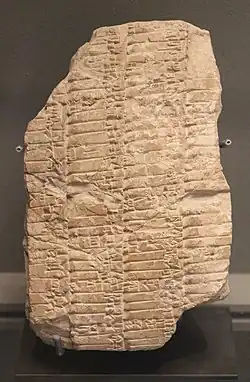TU-TA-TI scribe study tablets
The Tu-Ta-Ti scribe study tablets are tablets written in Cuneiform found all over Mesopotamia, used for a diverse set of languages, along a vast timespan of periods, and over many different cultures. The text originated in materials created for the study of writing ancient Sumerian, the language for which Cuneiform, with its signs and sounds, was originally invented.
These tablets are part of the Cuneiform Sylabary B from the second millennium, texts made to teach reading and writing in the Sumerian language found in presumably private schools in residential areas of Nippur and Ur.[1][2]
Description

Instructional tablets for teaching scribes have been found everywhere that Cuneiform was used. This "TU-TA-TI text in particular has been found all over Mesopotamia, in Nippur, and many other places. Sadly, some of the tablets, such as the one found in the Louvre museum, were purchased without information about their origins.[3]
The text originated in an ancient Sumerian reading and writing exercise, beginning with the signs TU, TA, and TI, and then "TU-TA-TI" - a word, possibly meaningless, built of these three signs, each representing a single syllable.
The signs are written in columns, each sign under the next and then the composite three-syllable "word".
After TU TA TI TUTATI comes NU NA NI NUNANI, and so forth, presumably to be read aloud in class while practicing writing. These tablets were divided in two, with the left side having the teacher's instructional text, while the right side was left blank for the student to practice, repeatedly writing and erasing it. This "TU-TA-TI" instructional text was studied in all the languages that used Cuneiform and found in the archaeological remnants of many cultures.[4]
Finding and deciphering
The artifact at the Louvre was purchased in 1910 by the archaeologist Elias Ibrahim Géjou. The original location of its finding is not known.[3]
According to Steve Tinney from Penn Museum, the TU-TA-TI text, used for studying pronunciation, had more than 80 syllables and was followed by a list of names to read and write.[1] All the artifacts of this text that have been found are broken fragments, so we cannot be sure.
Text
The sequence, read downwards in columns, beginning with the top of the left column and going down, is a sequence of 3 syllables:
- A syllable with U - pronounced oo.
- A syllable with A - pronounced ah.
- A syllable with I - pronounced ee.
After each sequence of three single syllables, U A and I, comes a three-syllable word with all three vowels.
For example: Tu Ta Ti TUTATI. Nu Na Ni NUNANI. Bu Ba Bi BuBaBi etc.
These are pronounced Too Tah Tee Toottahti, Noo Nah Nee Noonnahnee, etc.
Towards the end of the list, there are several syllables with an added ending consonant. So at the bottom of the 2nd column for example we find:
- Ur Ar Ir UrArIr. Tum Tam Tim TumTamTim. Ush Ash Ish UshAshIsh.
In Cuneiform transliteration, it is common to use the following signs for marking pronunciation:
- Sh is marked as S with a caron above: š
- Ng is marked as ŋ like it's IPA sign
- Hh glottal sound like Arabic Ha ح or Eastern Hebrew pronounced Het ח is marked as an H with a breve below: ḫ
- 'A - the glottal stop sound (IPA /ʔ/) is not marked, instead only the following vowel is shown. So 'Aar 'Aur 'Air are marked in standard cuneiform transliteration: Ar, Ur, Ir.
- -X - the syllable with the coda (ending consonant) X, but with no onset (opening consonant)
Consonant sequences
The leftmost column has the following consonants:
- T, N, B, Z, S, Hh, D, R, W, K
The second column to the left, read from top to bottom has the KU-KA-KI from the first column and then continues with L as follows:
- K L 'A M Sh, G, Ng, -R, TM, -Sh
The third column begins with the ending of the 2nd column: Ush'Ash'Ish. This column has only closed syllables with a coda (an ending consonant).
- -Sh, PR, -L, -Z, -K, -M, -D, -Hh, -'A,
There are a total of 44 sequences at most in any of the artifacts, which means 132 types of signs and therefore syllables, 176 examples to read and write, with a 264-letter count.
Comparison to the ancient Alphabet
External links
- About the TuTaTi exercise in Nippur and other places (see . Notes for a course called "Mesopotamian Lexical Lists – V: Old Babylonian period, Sign Lists and Syllabaries (I)", by Yale researcher Dr. Klaus Wagensonner. (published online 2021, Academia.edu)
- This presentation includes images of TuTaTi tablets: CUNES 50-02-055, NBC9560, HS1801 Heidicon,
- TA-TU-TI tablet at the Louvre. The exact original location of this finding is unknown.
- TA-TU-TI transliteration in English but without a transcription of the signs (PDF document at Elamit website)
- Pen State museum about Cuneiform study tablets, and their 17cm-high TU-TA-TI artifact from Nippur marked UPM CBS 14143 (figure #7 in the article, seen in the PDF). It is different from the artifact from Nippur shown on the Ottoman Lands website.
- Example of practice tablet from Nippur, with some of the tu-ta-ti text on the reverse side. (Cuneiform Digital Library Initiative CDLI website)
References
- Texts Tablets and Teaching Steve Tinney, Expedition Magazine 40.2 (1998), Penn Museum website
- []
- The Louvre TU-TA0TI tablet
- See TU-TA-TI instructional tablet image and explanation (in the Aftermath Tablets section of the Ottoman Lands Archaeological and Traveling website). This artifact is originally from Nippur.